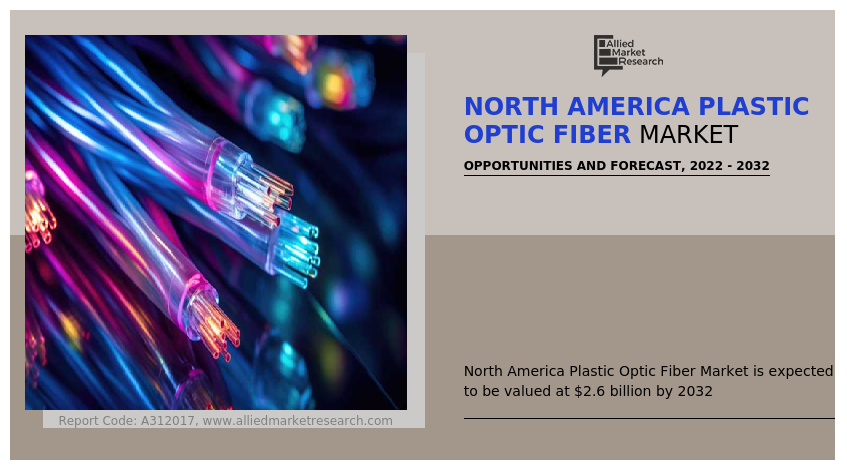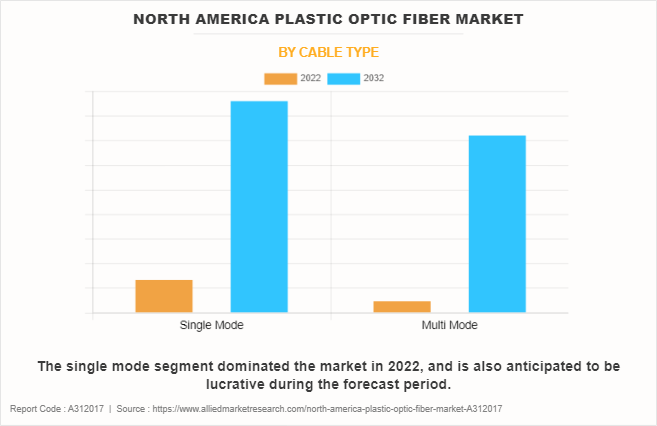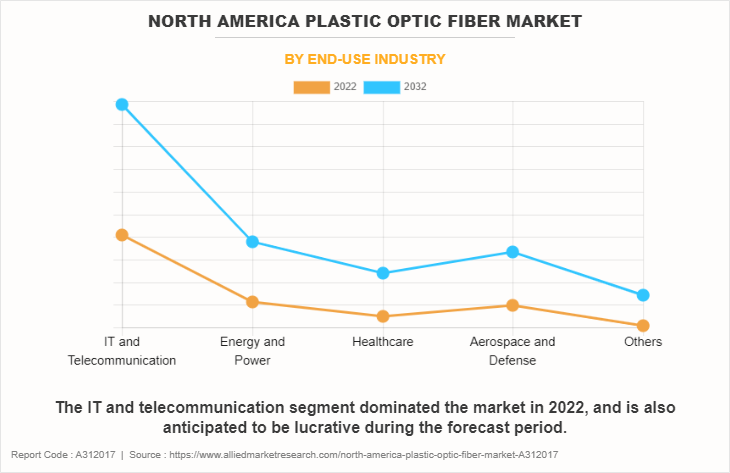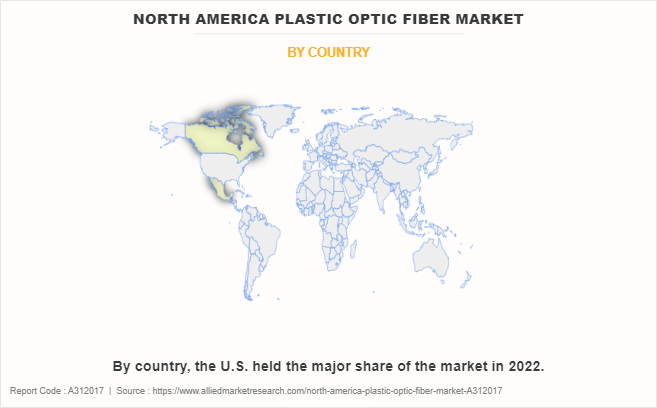The North America Plastic Optic Fiber Market is expected to reach a value of $2.6 billion by 2032.
Report Key Highlighters:
- The North America plastic optic fiber market size has been analyzed in terms of value ($Million). The analysis in the report is provided on the basis of cable type, end-use industry, and country.
- The North America plastic optic fiber market report includes a detailed study covering underlying factors influencing the industry opportunities and trends.
- The key players in the North America plastic optic fiber market analysis are AFL, Asahi Kasei Corporation, Chromis Fiberoptics, Clearfield, Inc., Electri-Cord Manufacturing Company, Fiberon Technologies, Mitsubishi Rayon Corporation, Molex, LLC, Timbercon, and Toray Industries, Inc.
- The report facilitates strategy planning and industry dynamics to enhance decision making for existing market players and new entrants entering the North America plastic optic fiber industry.

Plastic optic fiber is a high-speed transmission medium used in telecommunications and networking. It consists of a strand or strands of highly transparent material, usually plastic, through which light signals are transmitted over long distances. These fibers are incredibly thin, often as thin as a human hair, and carry large amounts of data encoded in pulses of light. The principle behind optic fibers involves total internal reflection, allowing light signals to travel through the fiber by bouncing off the inner walls, enabling fast and efficient transmission of data over vast distances.
The expansion of cloud services drives demand for plastic optic fiber in North America. Cloud services depend on robust and high-speed internet connections to transmit vast amounts of data seamlessly and efficiently. Fiber optic cables, known for their ability to transmit data at high speeds with minimal signal loss, play a crucial role in supporting this demand. In addition, the proliferation of cloud services, data centers, and high-speed internet infrastructure in North America necessitates reliable and efficient data transmission solutions. As a result, the demand for plastic optic fiber is increased to support these evolving technological needs, especially in scenarios where cost-effectiveness and flexibility are key considerations without compromising much on performance.
However, regulations related to industry compliance and compatibility with existing infrastructure impede the widespread deployment of plastic optics fiber (POF). Many systems, especially in telecommunications and data transmission, are designed around the specifications of glass fibers. In addition, deviation from these standards requires significant modifications or upgrades, potentially making the integration of POF into existing systems complex and costly. All these factors hamper the plastic optic fiber market.
Renewable energy systems such as solar and wind farms cover expansive areas. Monitoring these vast networks for performance, efficiency, and maintenance requires reliable communication and data transmission systems. POF flexibility and cost-effectiveness make it an attractive choice for transmitting data across these sprawling networks. In addition, its flexibility allows for easier installation around tight corners and difficult terrain, making it ideal for routing through complex environments often found in renewable energy sites. All these factors are anticipated to offer new growth opportunities in the North America plastic optic fiber market forecast.
The North America plastic optic fiber market is segmented on the basis of cable type, end-use industry, and country. On the basis of cable type, the North America plastic optic fiber market is divided into single mode and multi mode. On the basis of end-use industry, the market is segmented into IT & telecommunication, energy & power, healthcare, aerospace & defense, and others. On the basis of country, the North America plastic optic fiber market is analyzed across U.S., Canada, and Mexico.

The single mode was the highest revenue contributor to the market in 2022 and is expected to maintain its dominance during the forecast period. The evolution of communication technologies and the push for higher network speeds drive the demand for single mode cable in North America. As technologies such as 5G continue to expand, there is a growing necessity for robust, high-capacity fiber optic infrastructure to support the increased data traffic and ensure low-latency connectivity. Single mode fiber proves advantageous in these scenarios due to its ability to transmit large amounts of data reliably over short to medium distances.

IT & telecommunication was the highest revenue contributor to the market in 2022 and is expected to maintain its dominance during the forecast period. The increase in growth of data consumption, driven by streaming services, cloud computing, remote work, and IoT devices, necessitates robust infrastructure capable of handling enormous data volumes. Optic fibers, with their ability to transmit data at incredible speeds and over long distances with minimal signal loss, have become indispensable in meeting these escalating bandwidth demands.

The U.S. was the highest revenue contributor to the market in 2022 and is expected to maintain its dominance during the forecast period. The increase in digital transformation across various industries contributes significantly to the demand for optic fibers. Sectors such as healthcare, finance, education, and manufacturing are progressively dependent on digital technologies and cloud-based services. Optic fibers enable these industries to efficiently transfer vast amounts of data securely, facilitating telemedicine, financial transactions, online learning, and automated manufacturing processes.
Key players in the North America plastic optic fiber industry include AFL, Asahi Kasei Corporation, Chromis Fiberoptics, Clearfield, Inc., Electri-Cord Manufacturing Company, Fiberon Technologies, Mitsubishi Rayon Corporation, Molex, LLC, Timbercon, and Toray Industries, Inc.
Public Policies:
- Industry standards: Standards set by organizations such as the Telecommunications Industry Association (TIA) and the Institute of Electrical and Electronics Engineers (IEEE) outline specifications for fiber optic components, installation, and performance, ensuring interoperability and quality within the industry.
- National Electrical Code (NEC): The NEC provides guidelines for the installation and use of fiber optic cables, ensuring compliance with safety standards and proper installation practices to prevent hazards.
- Safety regulations: Regulations set by bodies such as the Occupational Safety and Health Administration (OSHA) establish safety measures for workers handling fiber optic equipment and installations to prevent accidents and ensure workplace safety.
- Federal Communications Commission (FCC) regulations: FCC regulations govern specific aspects related to telecommunications and transmission technologies, impacting the deployment or use of plastic optic fibers in certain communication systems.
Analyst Review:
According to the opinions of various CXOs of leading companies, the North America plastic optic fiber market growth is expected to the forecast period. Expansion of cloud services and rise in demand for high-speed internet have increased the demand for plastic optic fiber. Plastic optic fibers serve as critical infrastructure components, facilitating the transmission of vast amounts of data over long distances with exceptional speed and reliability. They are instrumental in supporting the expanding telecommunications landscape, enabling the seamless operation of modern communication networks.
The market growth is propelled by several factors such as the expansion of data-centric technologies, the transition toward 5G networks, and the ever-growing necessity for higher bandwidth capacities. Optic fibers, renowned for their adeptness in efficiently managing extensive data traffic, are increasingly indispensable in meeting the burgeoning requirements of digital communication. Furthermore, the continuous evolution of plastic optic fiber technology, encompassing enhancements in fiber materials, manufacturing methodologies, and transmission efficiency, stands as a primary catalyst for market expansion.
Key Benefits For Stakeholders
- The report provides a comprehensive analysis of the current market estimations through 2022-2032, which would enable the stakeholders to capitalize on prevailing north america plastic optic fiber market opportunities.
- Major countries are mapped according to their revenue contribution to the north america plastic optic fiber market.
- In-depth analysis of the north america plastic optic fiber market segmentation assists to determine the prevailing market opportunities.
- Identify key players and their strategic moves in north america plastic optic fiber market trends.
- Assess and rank the top factors that are expected to affect the growth of north america plastic optic fiber market share.
- Analyze the market factors in various countries and understand business opportunities.
- Player positioning provides a clear understanding of the present position of key market players.
North America Plastic Optic Fiber Market Report Highlights
| Aspects | Details |
| Market Size By 2032 | USD 2.6 billion |
| Growth Rate | CAGR of 8.3% |
| Forecast period | 2022 - 2032 |
| Report Pages | 100 |
| By Cable Type |
|
| By End-Use Industry |
|
| By Country |
|
| Key Market Players | SABIC, ExxonMobil Chemical Company, Eastman Chemical Company, Celanese Corporation, Dupont de Nemours, Inc., Dow Chemical Company, LyondellBasell Industries, Mitsubishi Chemical Holdings Corporation, Solvay SA, BASF SE |
The North America Plastic Optic Fiber Market is estimated to reach $2.6 billion by 2032
AFL, Asahi Kasei Corporation, Chromis Fiberoptics, Clearfield, Inc., Electri-Cord Manufacturing Company, Fiberon Technologies, Mitsubishi Rayon Corporation, Molex, LLC, Timbercon, and Toray Industries, Inc. are the leading players in North America Plastic Optic Fiber Market
1. The report provides a comprehensive analysis of the current market estimations through 2022-2032, which would enable the stakeholders to capitalize on prevailing market opportunities. 2. Major countries are mapped according to their revenue contribution to the north america plastic optic fiber market. 3. In-depth analysis of the north america plastic optic fiber market segmentation assists to determine the prevailing market opportunities. 4. Identify key players and their strategic moves in north america plastic optic fiber market. 5. Assess and rank the top factors that are expected to affect the growth of north america plastic optic fiber market. 6. Analyze the market factors in various countries and understand business opportunities. 7. Player positioning provides a clear understanding of the present position of key market players.
North America Plastic Optic Fiber Market is classified as by cable type, by end-use industry
Loading Table Of Content...
Loading Research Methodology...



